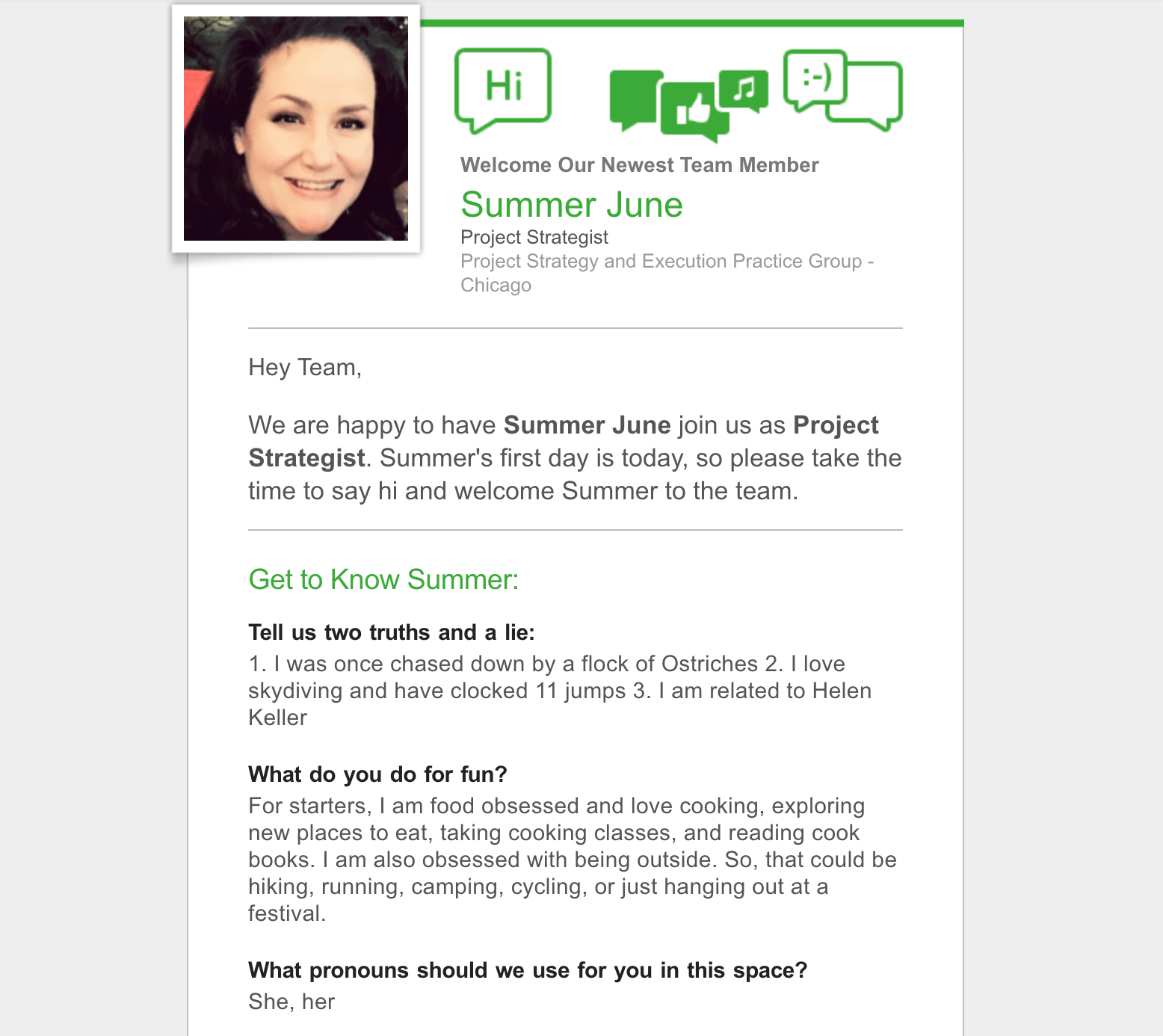No one puts a system for diversity recruiting in place when they start their business. We all just try to do our best to hire talented people we’ll get along with, and hire them fast. It’s only later that so many companies realize with a shock that all their colleagues look alike.
We always made an effort to include many voices at Table XI so we never had a totally homogenous team. But as we grew, we realized we needed an actual strategy for recruiting diverse candidates, not just good intentions.
First, a word on why diversity recruiting is important
When you’re putting resources into anything, you need to know why. We were lucky that for us, the diversity hiring goals were always very clear. We help companies build transformational products. Those products are used by all types of people. The more we reflect that audience, the better we’ll be at doing our job.
No matter what kind of business you’re in, you should start the project of improving your hiring by honestly answering what the importance of diversity in recruitment is for you. It’s not that advocating for equality and passing on privilege are bad reasons (they’re great ones, honestly). But you’ll be much more able to stay motivated and get the time and resources you need if you can point to the metrics that recruiting for diversity will help your organization improve. There’s no shortage of studies on the value of a diverse team, so simply identify the benefits that are most important to your team and build your plan around them.
How we overhauled — then systemized — our diversity recruiting efforts
The biggest problem with our hiring process is that it didn’t really exist. We had a formal, day-long program for interviewing and testing developers, but when we started hiring for other roles, we kind of just took that same system and tried to make it work for project strategists and UX designers. It felt cobbled together because it was.
Creating a new system gave us an opportunity to focus on what we were really looking for when we welcomed someone into Table XI. We brought in an HR consultant to work closely with us for six months while we came up with a system that reflected all of our goals, not just the ones for diversity and recruiting.
Recruiting diverse talent doesn't help if you can't retain them. Here's what we're doing to build an inclusive culture.
For each role that we fill, we came up with a series of four activities that best reflect the real-world work that job would do each day. For project strategists, one involved breaking down a case study. For developers, a coding challenge. For UX designers, a design exercise, etc. Then we used HR software Bamboo to made a rubric listing out the four behaviors we wanted to see from each role during each activity. We’d set the candidates up to show that behavior, and if they did it, they’d get a star.
Having a rubric also gives us a way to iterate on the process. It’s all written down, so if something’s not working, we know where to go back and make adjustments.
Reducing the role of judgement in recruiting to give diversity a better chance
The statistics about bias in hiring are alarming, and unfortunately hard to avoid if your hiring process is just you going with your gut. Even with the best of intentions, you’re still going to gravitate toward the people that look, sound and work like you, and you’ll come up with reasons they’re the “right” candidates.
All the diversity recruitment efforts in world won’t mean much if the interview and selection process isn’t a level playing field. That’s where our star system really shines. In the past, our hiring decisions were entirely based on personal judgements. And while we needed to curtail that, getting rid of judgement altogether does more harm than good. Now, each interview segment is worth five stars — four for the behaviors, and one for our discretion. Instead of instinct making up 100 percent of a candidate’s score, it’s now worth 20 percent.
The new system does a much better job of testing for the traits we’d need people to show on day-to-day basis in the role. We’ve done our best to compress big project behavior and simulate it in a short amount of time. It’s also made our decision-making process much faster, because we’re discussing observable behavior. If candidates earn fewer than two stars, we don’t move forward. For three, we have a discussion, and those with four or five almost always move forward.
Recruiting diverse candidates by creating an entirely new job
We realized pretty early on in this process that our team’s talent was actually acting as a barrier to creating opportunities for others. Because we’re a fairly senior team, no one can make our associate level fresh out of school. And yet that’s one of the best ages for recruiting diverse talent.
We believe strongly in learning here — you’ll find it mentioned all over our site. We wanted to offer that opportunity to everyone, not just people who were already several years into their careers. So we brought back our apprenticeship program and redesigned it so it works better for us and better for the young talent we wanted to support.
Now, we’re able to support two apprentices for six months. They pair closely with Noel Rappin, one of our lead developers, to rapidly grow their software development skills, but they’re also working on actual client projects (at a highly reduced rate), so they can get the real-life experience bootcamps don’t offer.
Apprenticeships are just one way we’re developing a diverse talent pool
By treating our apprenticeship program as an incubator for raw talent, we’re able to widen our net pretty dramatically and recruit diverse candidates earlier in their careers. But we’re also working to broaden that talent pool every way we can. Our staff regularly teach and/or mentor at Code Platoon, Girl Develop It and other bootcamps that help to bring more diversity into tech. And we host and attend diversity and inclusion events within our industry regularly, so we can encourage everyone to open up their doors to new candidates — and open up the industry to new people.
We’re also doing our best to look beyond our existing networks and find candidates who aren’t already a friend of a friend or a former colleague. Returning to the same old wells means we’ll end up with the same old people. It doesn’t give new faces a chance to break in. We’ve tested a variety of recruiting tools to reach diverse audiences, and we’ve had particular success with Vettery, a recruiting platform that sends us a batch of candidates from outside our network each week.
Why onboarding is such a critical part of our diversity hiring process
No matter who you are, starting a new job can be an intimidating and overwhelming experience. But some people have an easier time making their needs known and asking for help. We wanted to develop an onboarding process that would make starting at Table XI as easy as possible for everyone — like curb cuts, but for your career.
The first thing we did was look at our documentation, which was frankly a mess. It was all in Github, and really had the lingering feel of a shop that was all developer-focused, which Table XI hasn’t been in years.
We had to start from scratch. We came up with a list of all the things someone would need to know and do to really be a part of Table XI. Then we turned that list into tasks, and created checklists for each new employee that are automatically assigned to them and a cast of supporting people, with due dates. We also set up a system to handle all the basics — signing documents, sending over a bio and pronouns — before you start, so you come into the office prepared. And over the course of your first two months, a series of automatic emails will proactively introduce you to important elements of our culture that you can catch up with at your own speed.

Every time someone joins our team, the whole office gets an email like the above.
Now, when you arrive at Table XI for your first day, your computer and hoodie are waiting for you, and so is a paper schedule listing out the people you’ll meet with and tasks you’ll accomplish on your first day. There’s no awkwardness or worrying, because when it’s time for lunch, there’s already a table of people waiting to eat with you. As people complete all their new onboarding tasks, they quickly learn to speak the same language and feel like they’re a part of the same team — instead of relying on the unspoken cultural shorthand that not everyone shares.
Your diversity recruiting strategies are only as good as your retention strategies
We know that to have the kind of team we want to be on, and the team that can best serve our clients, we need to keep a focus on diversity in recruiting. But we also know that getting people in the door is just the first step. Everyone needs to feel welcome at Table XI if they’re going to get comfortable enough to share their work, their insights and their personalities. If we can’t keep people on our team, we’ve failed, full stop.
We’ve done a lot of work to make sure people from all backgrounds can be successful at Table XI, but there’s always more work to do. This year, we’ve made big strides in feedback, performance reviews and education that are helping to change our culture for the better.

